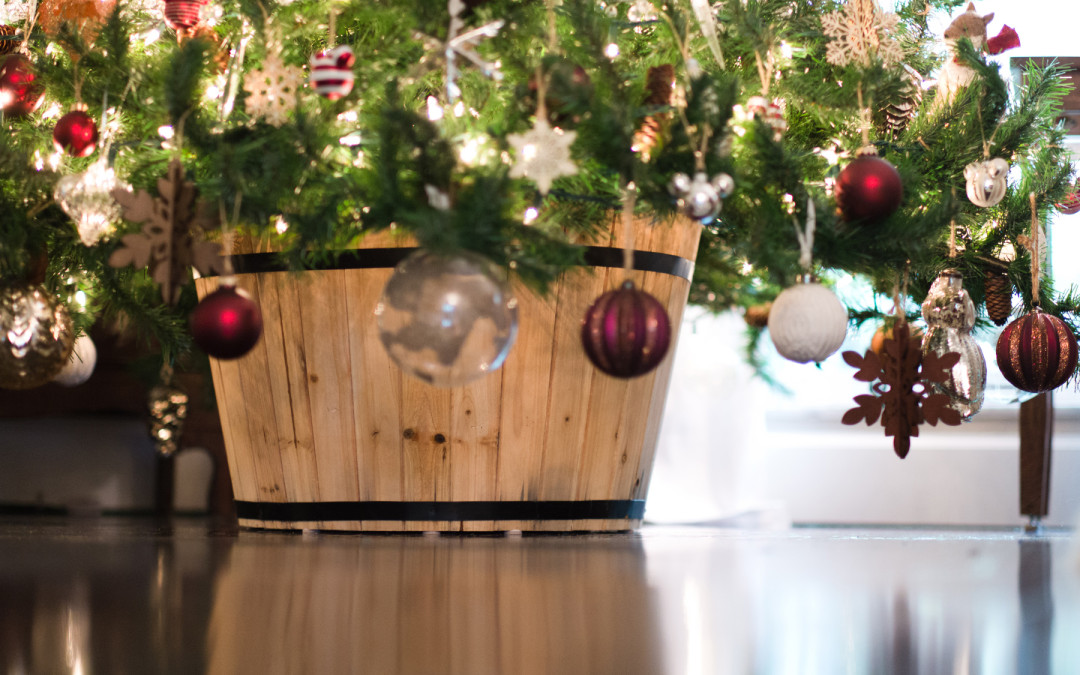As cat owners, we’ve long been frustrated with the traditional Christmas tree skirt. Our cats are frenzied beasts when the tree comes out, and they play extensively beneath the tree. The traditional skirt generally ends up 10 feet away from the tree at least once a week. When I saw the amazing Copper Tree Skirt at Terrain, I fell in love. But I wasn’t ready to shell out that much money (if you are interested in a less expensive option, this awesome Galvanized Tree Collar at Crate & Barrel fits the bill). Early last year I found a large planter for less than $20 at Bed, Bath, & Beyond, and I figured I could turn it into some kind of Christmas Tree planter. It has been sitting in storage for 9 months, so I was happy to get it out and go to work. There were two different ways we could have used the planter – flipped upside down over the original tree stand or stand it upright and construct a support inside. We went with the upright solution, but I will briefly describe the other option at the end if you would like to save some money.
**It should be noted that these directions are for a tree stand that supports an artificial Christmas Tree. See modified directions for a real tree at the very end of this post.**
Materials
- Large Wood Planter
- 12-inch tall, 1-1/4-inch diameter galvanized nipple (diameter is based on your tree base size; measure height based on planter – it should be near the top of the planter)
- 1-1/4-inch diameter galvanized flange (diameter should match the nipple)
- Four (4) 1-1/2-inch long, 1/4-inch diameter hex bolts
- Four (4) 1/4-inch diameter hex nuts
- Eight (8) corresponding washers
- Extra Wood for Support – such as a Pine 2x4
- Weights for the bottom of the stand
Tools
- Drill (we prefer dewalt) (no, they don’t sponsor us) (hint, hint dewalt)
- 5/16-inch drill bit
- crescent wrench
- socket wrench
- 1-1/2-inch spade bit OR hole saw
- sand paper or dremel too with sander bit
The first step in creating the Christmas Tree Planter look is to purchase a large wood planter. It needs to be at least 20 inches across the bottom to support the tree. One great but somewhat expensive option is Whisky Barrel Planter from Home Depot. If you get a planter that large, you can often fit the tree base in the planter, possibly supported by some concrete pavers from the outdoor department. Large planters tend to be tall, so you may need to lift your tree up to 6 inches higher. Measure your tree and ceiling height before finalizing your construction.
We bought a 1-1/4-inch diameter galvanized flange and a 12-inch tall, 1-1/4-inch diameter galvanized nipple from Home Depot. These both act as the major supports for the tree. I brought part of my actual tree into the store to make sure we purchased the correct diameter. The first step is to place the flange centered on the bottom of the planter and mark the location of the four holes. You will be using 1/4-inch diameter hex bolts to connect the flange, so you will need a 5/16-inch drill bit. Using a drill with the correct bit, drill a hole at each mark.
We connected the flange to the planter using 1-1/2-inch long, 1-/4-inch diameter hex bolts, along with the corresponding washers (two per bolt) and 1-1/4-inch diameter hex nuts. We pushed the bolts in from the bottom of the planter to prevent any issues with the bolts extending past the bottom of the planter. First place a washer over the hole, and then place a bolt through the hole. Do the same for all four holes. Carefully flip the planter over without losing the bolts.
Place the flange over the bolts and place a washer over each bolt, on top of the flange. Take the 1/4-inch diameter hex nuts, and screw them over each washer by hand. The next step is to tighten the nuts. You will need a crescent wrench to hold the end of the bolts in place as you tighten each nut with a socket wrench (or you could use a pair of pliers or another crescent wrench in a pinch). Place the crescent wrench over the bolt head and tighten it to hold the bolt firmly in place. Then take the socket wrench and place it over the nut, Twist the handle to turn the nut. Stop when you can tighten no longer. Repeat for each bolt.
The next step in the process is to screw the nipple into the flange. Make sure to screw it in tightly so the connection is solid.
We placed part of the tree int the tree stand and quickly realized that we needed additional support. The final step is to provide support. There are many solutions, but this is the option we chose. We cut the pieces from scrap pine 2x4s. We measured the diameter of the planter at two different locations near the center. We cut two lengths from the 2x4s that corresponded to the measured diameters. We then tested the lengths to be sure they fit near the center of the planter and that they would support the tree at different heights (see photo final photo). Once we were happy with the lengths of the supports, we drilled a hole in the center of each support using our trusty drill and a 1-1/2-inch spade bit (you could use a hole saw). We enlarged the holes slightly to fit over the nipple by sanding them with a dremel tool and sander bit (you can use sand paper by hand).
We placed each support over the nipple. One important final step is to add some kind of weights to the bottom of the stand. You can purchase rounded pavers from the outdoor department at your local hardware store and place them in the bottom of the stand around the flange. Or you could do what we did and recycle some unused SCUBA lead weights by throwing them into the tree stand. Just be sure to add something to make sure your tree won’t tip over. Now all you do is place the tree into the nipple – no need for the original stand!
*Our tree base is 1-1/4-inches in diameter and so we used 1-1/4 inch products. Your tree base may be thicker or thinner, so check the dimensions before you purchase materials. Keep in mind that bolt sizes may vary depending on flange size. Check the bolt with the flange at the store before purchasing.*
**There are three alternative construction methods that may save you time and money:
- If you purchase a large enough planter, you may be able to place the entire tree, original stand and all, in the planter. If the stand will fit in the planter, but will not go all the way to the bottom, the easiest solution is to purchase concrete pavers from the outdoor department at the hardware store to act as a platform for the tree stand.
- If the original tree stand will fit within the top of the planter, but not the bottom (this was the case for us), you can drill a large enough hole in the bottom of the planter and flip it upside down OVER the tree stand. Then slip the tree through the hole into the tree stand. You can use a spade bit or a hole saw to make the hole. This works best for artificial trees.
- The final option is to flip the planter over and cut most of the bottom out. You can use a skil saw to cut most of the bottom of the planter away. Then you can place the upside-down planter over the tree base. This should work for both real and artificial trees.**


























Recent Comments